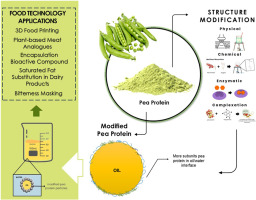Why Food Manufacturers Are Turning to Pea Protein for Next-Gen Product Innovation
As global consumer preferences shift toward health, sustainability, and plant-based living, food manufacturers are increasingly reevaluating their ingredient choices. One ingredient that has emerged as a versatile powerhouse in food formulation is pea protein. With its functional benefits, nutritional profile, and clean-label appeal, the application of pea protein is transforming how companies approach product development.
For business owners, R&D teams, and formulation specialists in the food manufacturing sector, understanding how pea protein fits into the current market and operational priorities is essential for staying competitive and meeting evolving consumer demands.
The Growing Appeal of Pea Protein in B2B Food Innovation
Pea protein, derived primarily from yellow peas (Pisum sativum), has become one of the most sought-after plant-based proteins in the market. Its appeal stems from several key business drivers:
- Plant-Based Trend: The rise of vegan, vegetarian, and flexitarian consumers has led to an explosion in demand for meat and dairy alternatives.
- Allergen-Friendly Formulation: Pea protein is naturally free from common allergens such as soy, dairy, and gluten, making it an ideal base for inclusive product lines.
- Nutritional Benefits: It provides a well-balanced amino acid profile, excellent digestibility, and high protein content—appealing to health-conscious consumers.
- Functionality: Its emulsifying, gelling, and water-holding capabilities enhance texture and stability across a wide range of applications.
Key Applications of Pea Protein Across Food Categories
From a B2B perspective, what makes pea protein a game-changer is not only its nutritional value but also its adaptability across product formats. In fact, Satoria’s article, “Pea Protein in Action: Key Applications for Food Manufacturers” highlights how pea protein is being strategically applied in:
- Meat Alternatives: Used to mimic the bite and mouthfeel of meat, pea protein is a staple in plant-based burgers, sausages, and deli slices.
- Dairy Replacements: In beverages, yogurts, and cheese analogs, it provides structure and protein fortification while maintaining a neutral taste.
- Snacks and Nutrition Bars: Pea protein isolates are often used in high-protein snacks, granola bars, and sports nutrition products for added satiety and functional benefits.
- Bakery and Pasta: Its gelling and emulsifying properties improve dough texture and shelf life without compromising taste.
The versatility of this ingredient allows manufacturers to create differentiated SKUs that meet health trends and dietary requirements—all while managing operational efficiencies.
Operational Benefits for Food Manufacturers
From a business operations perspective, working with pea protein also brings several strategic advantages:
- Cost Stability: Compared to animal-based proteins, plant proteins such as pea tend to have more predictable pricing and supply chain resilience.
- Sustainability & ESG Alignment: Pea cultivation is more environmentally friendly, requiring less water and fewer inputs than many other protein sources. Using pea protein supports ESG goals, appealing to both regulators and ethical investors.
- Clean Label Potential: Pea protein contributes to shorter ingredient lists and is often perceived as “natural” and non-processed by consumers—enhancing your product’s transparency.
These factors can help reduce time-to-market, meet regulatory standards, and improve brand perception in a crowded marketplace.
Choosing the Right Pea Protein Partner
For manufacturers looking to capitalize on the benefits of pea protein, sourcing high-quality ingredients from a reputable supplier is critical. Satoria, a leading food ingredient innovator, offers pea protein isolates that meet the high standards required for commercial food production.
Their formulations are designed with the functional needs of food developers in mind—whether you’re looking to enhance texture, improve protein content, or align with clean-label goals. Satoria’s team also supports partners through formulation trials and technical support, ensuring seamless integration into your production lines.
Additionally, Satoria provides textured pea protein, an ideal ingredient for meat analog development. This product delivers the fibrous texture consumers associate with real meat, making it a perfect fit for brands targeting the fast-growing plant-based protein segment.
Market Outlook: Investing in the Future of Food
According to global market trends, the demand for plant-based ingredients is expected to grow at a CAGR of over 8% through 2030. This represents a massive opportunity for B2B players in the food sector to diversify product offerings and build future-ready portfolios.
Forward-looking food manufacturers that invest in the application of pea protein today stand to benefit from:
- Faster product innovation cycles
- Increased shelf appeal with “plant-based” claims
- Access to new consumer segments, including Gen Z and millennial health-conscious buyers
Final Thoughts
For business leaders in the food manufacturing industry, now is the time to act. Pea protein is no longer a niche ingredient—it’s a mainstream solution for innovation, sustainability, and growth.
To explore how your business can leverage pea protein in future formulations, we recommend reviewing Satoria’s expert insights on pea protein applications and exploring their specialized product offerings designed specifically for food manufacturers.
The shift to plant-based isn’t just a trend—it’s a transformation. And pea protein is at the heart of it.
